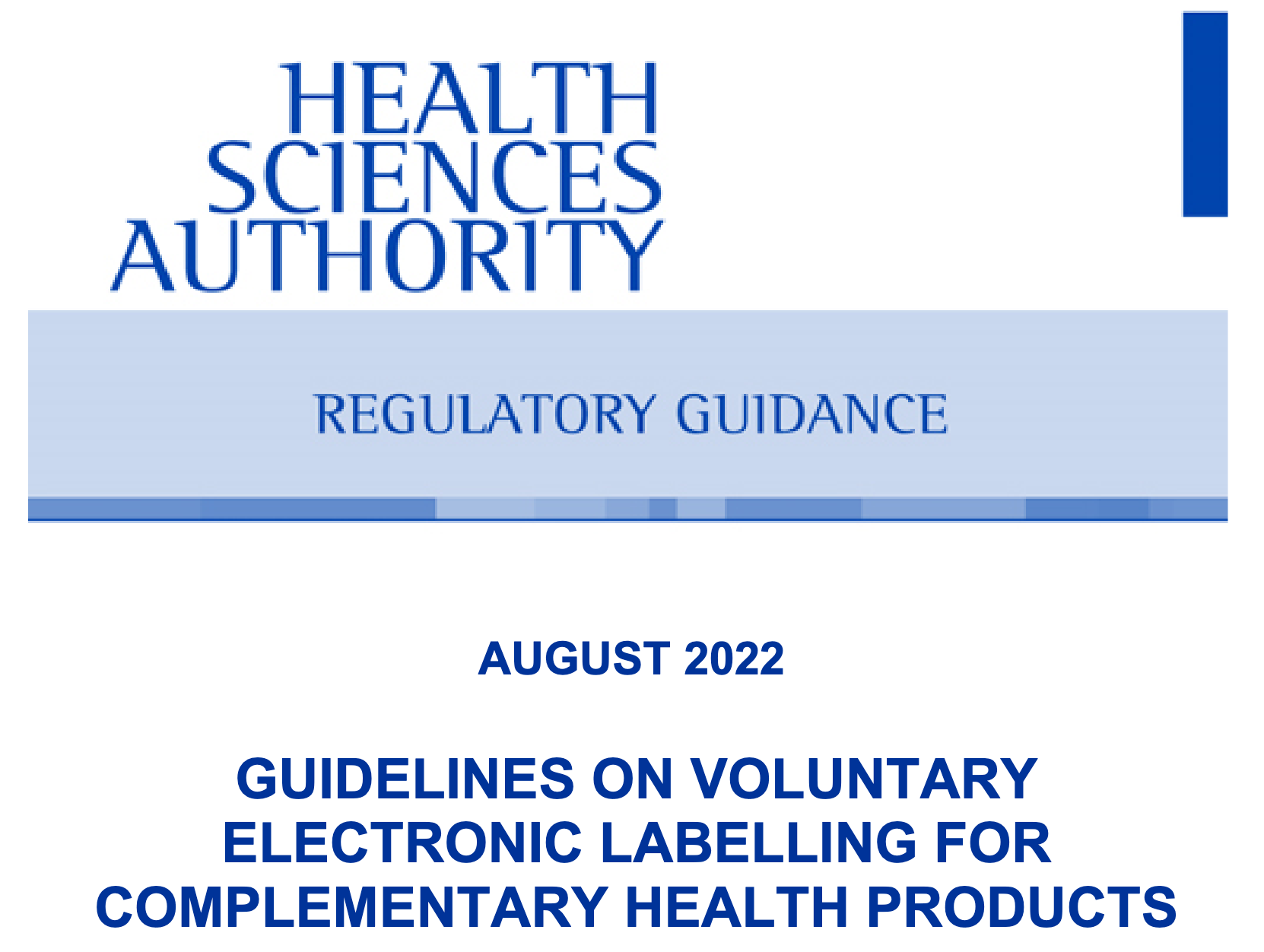Singapore’s Health Sciences Authority (HSA) is embracing innovation in healthcare communication through the use of electronic labelling (e-labelling) or eLeaflets. This digital approach provides product information for therapeutic products via online platforms, enhancing accessibility and ensuring users receive up-to-date information. The implementation of e-labelling varies by product type and is evolving with ongoing pilot projects.

Background
Electronic labelling (e-labelling) refers to product information, including the package insert (PI) and patient information leaflet (PIL), which is distributed via electronic means, such as through a machine-readable code or URL on the product carton that links to a secure online system that publishes the product information in digital format. Registrants of Therapeutic Products (TP) who have a secure online system may distribute the HSA-approved PI and/or PIL in the form of an e-PI/PIL.
The e-PI/PIL may be distributed with or without physical printed copies contained in the products.
Benefits of E-Labelling
E-labelling represents a significant step toward modernizing healthcare communication in Singapore, ensuring that consumers receive accurate, accessible, and environmentally friendly product information.
E-labelling offers numerous advantages:
- Enhanced Accessibility: Users can access updated product information anytime, even if they no longer have the packaging.
- Environmental Sustainability: Reducing reliance on printed materials supports Singapore’s sustainability goals.
- Improved Consumer Understanding: Interactive content, such as videos or graphics, could make product usage instructions clearer and more engaging.
GENERAL GUIDANCE FOR E-LABELLING
Products eligible for e-labelling
HSA is taking a phased approach to facilitate the implementation of e-labelling of Therapeutic Products (TP) . Presently (January 2025), e-labelling is applicable to prescription-only medicines (POM) only.
Acceptable e-labelling formats
E-labelling should be presented in a machine-readable digital format that would allow optimised viewing on devices such as smartphones/laptops/tablets. In addition to the e-PI/PIL statutory information additional information can be considered like, for example, online videos on instruction for use (e.g. inhalers/injectable pen devices) or audio tools in support of the visually impaired.
Accessibility of e-labels
Product Registrants who opt to adopt e-labelling are responsible for ensuring that the hosting platform has high availability for users to access the e-label online. The information should preferably be accessible to user via a direct link to the e-label. Alternatively, a landing webpage with information pertaining only to the Therapeutic Product of interest may be considered, provided that the time spent by the user navigating the page (e.g. clicking links, scrolling) is minimised. Users should not be asked for their personal information or required to log in or register with the site before accessing the e-label. Product registrants may state the URL (short link preferred), QR code, or other machine-readable code on the outer packaging (e.g. outer carton) of the TP. In addition, appropriate instructions on how to access the e-labels should be stated.
Registrant’s roles and responsibilities
Product registrants are responsible for ensuring that the e-labels published on its websites are up-to-date and aligned with the product information registered with HSA. The e-label should be made available to users within 30 days of any update of product labelling.
Notification of e-labelling
Product registrants are required to complete and submit the online notification form prior to actual implementation of e-labelling for registered TPs. Machine-readable codes (e.g. QR codes) may be included in the outer packaging without notifying HSA.
Non-prescription Therapeutic Products (Pharmacy only and General Sale List)
Background
E-labelling has been implemented for prescription-only therapeutic products (TP) since April 2021. HSA is assessing the feasibility of extending e-labelling to non-prescription TPs. As part of a calibrated approach and in consultation with industry stakeholders, HSA will initiate a pilot exercise from 1 April 2024.
Key Features of the Pilot Project
- Voluntary Participation: Registrants of non-prescription medicines can voluntarily participate while adhering to current labelling requirements.
- QR Codes and URLs: Packaging features QR codes or URLs that direct users to secure platforms hosting HSA-approved digital labels.
- Consumer Accessibility: The pilot ensures e-labels are user-friendly and accessible across multiple digital devices.
- Feedback Collection: Feedback on user experience is collected to refine the e-labelling system.
Eligibility for participation in e-labelling pilot
- The eligibility criteria for the e-labelling pilot are as follows:
- The current forensic classification of the product is Pharmacy only (P) or General Sale List (GSL).
- The products are supplied to end users as consumer packs intended for short-term treatment with product information presented in a Patient Information Leaflet (PIL) format. The electronic PIL (ePIL) may be implemented with or without a physical paper leaflet. In addition to the standard labelling requirements for the outer carton of the product/s, the following minimum safety information are required along with the machine-readable code (e.g., QR code) directing the user to the complete product information via the ePIL. The minimum labelling requirements provide the necessary safeguard to ensure appropriate use of the medicine in the event that consumers are unable to access the ePIL in the absence of a paper leaflet.
Submission of request to participate in the e-labelling pilot
Complete and submit a form to notify HSA of the company's interest to participate. The following information is required in the submission: i) Name of product ii) Current forensic classification iii) Proposed pack size iv) Proposed artwork plan for Outer carton including machine-readable code (Refer to Tablev1 for labelling requirements) v) Justifications for not providing minimum safety information, if any vi) Monitoring channels/sources (Customer reports, Adverse events reports, Website traffic) (Refer to sections 6 and 7 below)
Implementation of e-labelling during pilot phase
Upon HSA’s acknowledgement to participate in the pilot: i) If the current registered outer carton already meets the minimum safety information criteria: Submit a ‘Do-and-Tell’ form to implement e-labelling for the pilot phase. ii) If the minimum safety information criteria are not met: Submit a packaging variation application to update the outer carton.
What’s Next?
The results from the pilot project will determine whether e-labelling is extended to non-prescription medicines. If successful, HSA could formalise this approach, benefiting both consumers and the pharmaceutical industry.
The duration of the pilot phase is tentatively 18 months from 1 April 2024 till 31 July 2025.

ELECTRONIC LABELLING FOR COMPLEMENTARY HEALTH PRODUCTS
Background
- Electronic labelling (e-labelling) refers to product information which is distributed via electronic means, such as through a machine-readable code (e.g. QR code) or URL on the product outer packaging, that links to a secure online system which publishes the product information in digital format. Presently, e-labelling for Complementary Health Products (CHP) is applicable to the product leaflet1 (PL) only.
- The objective of e-labelling is to facilitate consumers’ access to updated product information in a timely manner.
- CHP dealers who have a secure online system may distribute the PL in the form of an e-PL. The e-PL may be distributed with or without physical printed copies contained in the products.
E-labelling may be used on all types of CHP. Currently, CHP include :
- Chinese Proprietary Medicines (CPM),
- Health Supplements (HS)
- Traditional Medicines (TM)
- any other CHP as determined by the Health Sciences Authority (HSA).
Acceptable e-labelling formats
E-labelling should be presented in a machine-readable digital format that would allow optimised viewing by consumers on devices such as smartphones/laptops/tablets
Accessibility to product information
- CHP dealers which opt to adopt e-labelling should ensure that the host website (i.e. website of individual companies or industry associations) has in place the necessary infrastructure and support system to allow users to access the e-label online.
- The information should preferably be accessible to all users via a direct link to the e-label pertaining only to the CHP of interest. Alternatively, a landing webpage with information on that CHP may be considered, provided that the time spent by the user navigating the page (e.g. clicking links, scrolling) is minimised. Users should not be asked for their personal information or be required to log in or register with the site before they can access the e-label.
- Companies may state the URL (shortlink preferred), QR code, or other machine-readable code on the outer packaging (e.g. outer box) of the product. Appropriate instructions on how to access the e-labels should also be included.
Roles and responsibilities of companies (CPM products)
Companies are not required to submit CPM amendment applications for any changes to current approved CPM labels solely to incorporate QR code or URL to the e-labels. For other changes to the product labels, the e-labels should be updated within 30 days of approval of any label update.
For other CHP such as Health Supplements and Traditional Medicines which are currently not subject to pre-market approval by HSA, dealers who are interested to implement e-labelling should just inform the HSA by submitting an online form.
A very informative Q&A section is available in the following document: GUIDELINES ON VOLUNTARY ELECTRONIC LABELLING FOR COMPLEMENTARY HEALTH PRODUCTS
Sources
For more information, refer to the official documents:
- HSA guidance document (Appendix 7A)
- Guidance for the implementation of electronic labelling (e-labelling) for Non-prescription Therapeutic Products (Pharmacy only and General Sale List)
- GUIDELINES ON VOLUNTARY ELECTRONIC LABELLING FOR COMPLEMENTARY HEALTH PRODUCTS
For more details on Singapore’s e-labelling initiatives, visit the HSA's official guidance documents page.